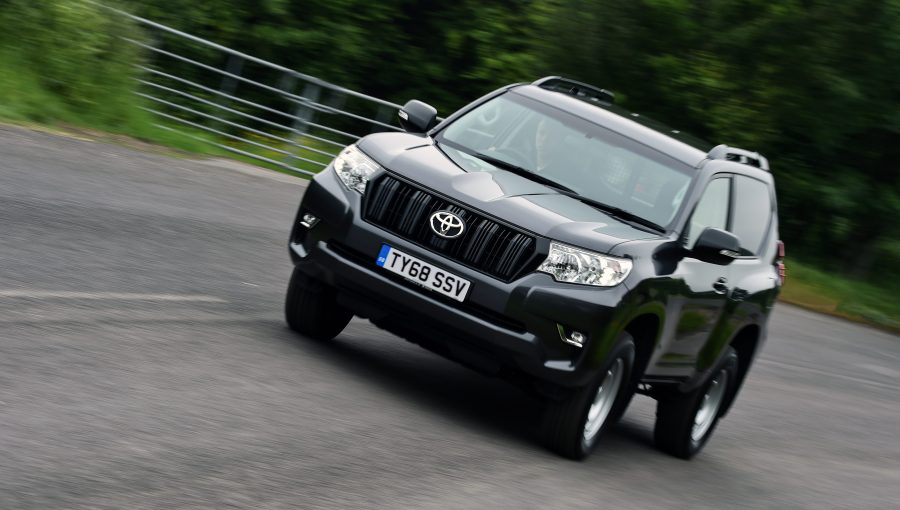Although Toyota’s passenger car range is predominantly focused around petrol-electric hybrid powertrains, the Land Cruiser, Hilux and Proace models are fitted with diesel engines. A diesel particulate filter (DPF) is a feature of these models, and you may have heard about the need for regular DPF regeneration. What does this component do and how do you take care of it?
What does a diesel particulate filter (DPF) do?
The DPF is fitted within the exhaust system and is designed to catch soot particles and nitrous oxide (NOx) from the combustion process that would otherwise be released into the atmosphere. The DPF is highly effective and traps around 80% of these harmful particulates.

Why do modern diesel engines need a DPF?
European legislation places strict exhaust emissions targets on all vehicle manufacturers. From September 2009, the Euro 5 legislative standard came into effect, part of which required all diesel cars registered from that point on to be equipped with a diesel particulate filter, or DPF.
These filters are used throughout the industry in all diesel-powered passenger vehicles, and their efficiency is vital now that stringent Euro 6d emissions standards are in force.
Do I need to replace a DPF during normal servicing?
Diesel particulate filters do have a capacity limit and can become full. But unlike traditional air, oil or pollen filters that need to be exchanged manually at regular intervals, the DPF has a much longer service life and is designed to regenerate to restore its performance.
The car’s electronic control unit (ECU) is programmed to do this automatically, neutralising the soot by burning it off at high temperature within the exhaust system while the vehicle is running. All modern cars with diesel engines follow this procedure.

How does DPF regeneration occur?
The regeneration occurs automatically, usually without the driver being aware that it is taking place. In the majority of cases, the process is carried out when the engine and exhaust system has reached normal operating temperature and the vehicle is travelling at over 40mph.
However, if your driving is limited to urban areas, the low speeds and frequent stops mean the conditions for normal regeneration do not exist. In these instances, the ECU monitors the accumulation of soot and instructs an alternative regeneration programme to begin well before the filter becomes saturated.
This programme injects small quantities of fuel into the engine after combustion, which increases the temperature within the exhaust system and creates an environment where it is possible to safely burn off the soot.
This method is very successful within the small percentage of vehicles where normal regeneration is not possible. However, due to the nature of city traffic, the regeneration process can be interrupted when the vehicle completes its short journey and is turned off. If this occurs, the ECU is programmed to recommence the process when the engine is restarted and back up to temperature again.

How can I help prevent DPF blockages in my Toyota?
Follow these four simple actions:
1. Regularly drive your Toyota on highways at speeds of between 40-55mph for around 20-30 minutes.
2. Avoid spending unnecessary amounts of time with the engine idling.
3, Try to limit the frequency of short journeys where the engine is running for less than ten minutes.
4. Do not ignore dashboard alerts related to the DPF.
Will I be warned if all DPF regeneration processes have been unsuccessful?
Very occasionally, use of the vehicle might be such that it will have been impossible for the ECU to complete the administration of any regeneration procedure. At this point, the DPF will have become overloaded and stopped functioning, so your Toyota will illuminate a warning light in the dashboard. It will then be necessary for the soot to be neutralised and the filter regenerated manually at a main dealer.
It is extremely unwise to ignore this visual warning as the DPF can become irreparably damaged. What’s more, it is illegal to remove the filter entirely.
Learn more: What is the exhaust gas recirculation valve and what does it do?





My Toyota proace verso DPF light is on and toyota can not fix it
Hi there,
Thanks for getting in touch. We will email you directly in order to help you further with this.
Thanks.
Hi can you advise me I bought Toyota Avinses 2016 just 2 weeks just seen on the screen DPF is full is this serious or easy I have 60 days warranty
Hi Michael,
Thanks for getting in touch. We would recommend visiting your nearest dealer as they will be best equipped to assess this in person. You can find your nearest dealer via this link: https://www.toyota.co.uk/forms/forms?tab=pane-dealer
Thanks.
Hi James,
Thanks for getting in touch. We are sorry to hear about your issues and the distress it may have caused. Without being able to assess your car in person, we cannot provide an answer ourselves. In this case, we would recommend re-visiting your nearest Toyota centre as they are best equipped to evaluate the car.
Alternatively, if you would like to discuss the situation further with our team, would you like to us to put you in touch with our customer relations team?
Thanks.
2011 Yaris 1.4 d4d. My DpF filer is blocked by soot, as seen on mechanics computer, However I commute on motorway for 90 minutes round trip ( with short journeys in-between at home) I’ve done this commute at speeds of between 40 & 50 mph, 3,000 rpm several times in an attempt to force a regen and yet the Dpf is stll blocked.
Hi Mike,
Thanks for getting in touch. We would recommend visiting your nearest Toyota centre as they are best placed to assess the car for any potential issues and make any necessary recommendations. You can find your nearest centre via this link: https://www.toyota.co.uk/forms/forms?tab=pane-dealer
Thanks.
Can you tell me if my Rav FN06 ONM has a dpf please? Thank you”
Hi Andrea,
Thanks for your message. Your vehicle is not fitted with a DPF.
Thanks.
DPF FULL; REFER TO YOUR USER MANUAL
I’m getting the warning less than 24hours of picking up my avensis 2016
What do I do?
Hi John,
Thanks for your message. We would recommend re-visitng your nearest Toyota centre to have the DPF checked over.
Thanks.
I have a 2010 Avensis D4D. VIN number SB1ED76L00E045869. It’s done 121,500 miles. Please can you tell me if it has a DPF? It’s getting to the age and mileage where I’d anticipate problems, if it has, so it would be really helpful to know to help with the decision on whether to keep the car, which has been excellent and which I still like very much, or whether it’s time to trade it in. Thank you.
Hi Richard,
Thanks for getting in touch. We’ve now checked this with our technical team and your Avensis is listed as having a DPF.
Thanks.
Just for my understanding, do we need to regularly change oil so as not compromise the DPF. Or in some cases that if we seldom used the car. Lets say it sit for more than 5 months and have not used it for more than 5000 kms. Because some dealer require to have the oil changed every 5000 kms or 6 months which ever comes first. Assuming that actual mileage used is 3000 kms. Thanks for your response.
Hi Edwin,
Thanks for getting in touch. Could you please provide us with your reg? We can then check this with our technical team.
Thanks.
Hi please can you if my vehicle reg LR55 YME is fitted with DPF? Thanks